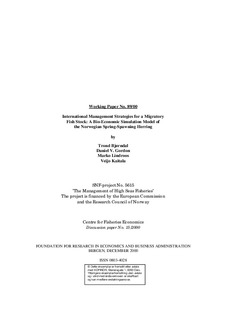International management strategies for a migratory fish stock : a bio-economic simulation model of the Norwegian spring-spawning herring
Working paper, Working paper

Åpne
Permanent lenke
http://hdl.handle.net/11250/165968Utgivelsesdato
2000-12Metadata
Vis full innførselSamlinger
- Working papers (SNF) [809]
Sammendrag
In this paper, a three-country dynamic bio-economic simulation model is presented for the spring-spawning herring fishery. The international spring-spawning herring fishery, based on potentially one of the most valuable fish stocks in the world, is currently recovering from a severe depletion of the stock and subsequent harvesting moratorium. Management of the herring fishery is complicated by its multi-nation exploitation, due to the highly migratory behaviour of the species moving between several coastal state zones (exclusive economic zones, EEZ's) and the high seas (Ocean Loop). Based on extensive work invested on analysing both the biology of the herring stock and the fisheries economics around its exploitation we study here the profiles of different multi-agent management schemes, simulating catch levels, stock size and profit potentials of alternative management strategies. The stock dynamics are described by a linear discrete-time age-structured population model and the economics are presented by a rent maximising model with constant price of herring catch and different costs of harvesting and efficiency levels for the different national fleets. The simulations, carried out over several decades, show that the benefits of international co-operation far exceed the returns of a competitive open access fishery.
Utgiver
SNF / Centre for fisheries economicsSerie
Working paper2000:89
Discussion paper
2000:15